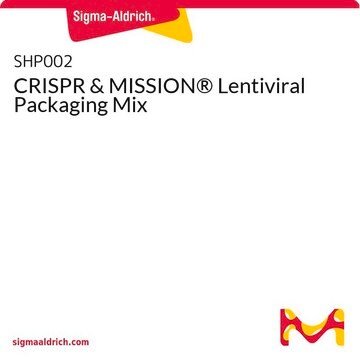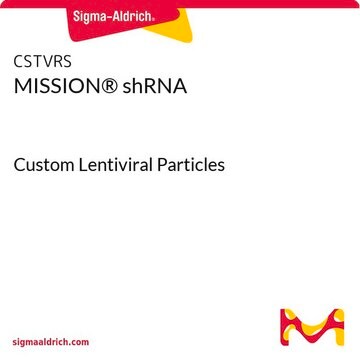SHP001
MISSION® Lentiviral Packaging Mix
Production of replication incompetent viral particles
Sinónimos:
Lentiviral Packaging, Lentiviral Packaging Kit
About This Item
Productos recomendados
product line
MISSION®
storage temp.
−20°C
Categorías relacionadas
General description
The MISSION® Lentiviral Packaging Mix is an optimized formulation of two plasmids expressing the key HIV packaging genes and a heterologous viral envelope gene.
Lentiviral particles are generated from three main components:
- The packaging vector, which contains the minimal set of lentiviral genes required to generate the virion structural proteins and packaging functions.
- The vesicular stomatitis virus G-protein envelope vector, which provides the heterologous envelope for pseudotyping.
- The shRNA transfer vector, which contains the sequence of interest as well as the cis acting sequences necessary for RNA production and packaging.
The Lentiviral Packaging Mix contains the first two components; it is designed to be co-transfected along with a compatible lentiviral transfer vector in order to create high-titer pseudo-typed lentiviral particles used for downstream transduction applications.
Application
Other Notes
Legal Information
Storage Class
10 - Combustible liquids
wgk_germany
WGK 2
flash_point_f
Not applicable
flash_point_c
Not applicable
Certificados de análisis (COA)
Busque Certificados de análisis (COA) introduciendo el número de lote del producto. Los números de lote se encuentran en la etiqueta del producto después de las palabras «Lot» o «Batch»
¿Ya tiene este producto?
Encuentre la documentación para los productos que ha comprado recientemente en la Biblioteca de documentos.
Los clientes también vieron
Artículos
MISSION shRNA reduce the expression of specific target genes by targeting the specific mRNA therefore reducing the corresponding protein expression.
When shRNA is delivered using lentiviral vectors, the sequence encoding the shRNA is integrated into the genome and the knockdown effect is passed on to daughter cells, continuing gene silencing.
Protocolos
Preparation of the Lentiviral Transduction Particles Using Packaging Plasmid Mix
Nuestro equipo de científicos tiene experiencia en todas las áreas de investigación: Ciencias de la vida, Ciencia de los materiales, Síntesis química, Cromatografía, Analítica y muchas otras.
Póngase en contacto con el Servicio técnico








